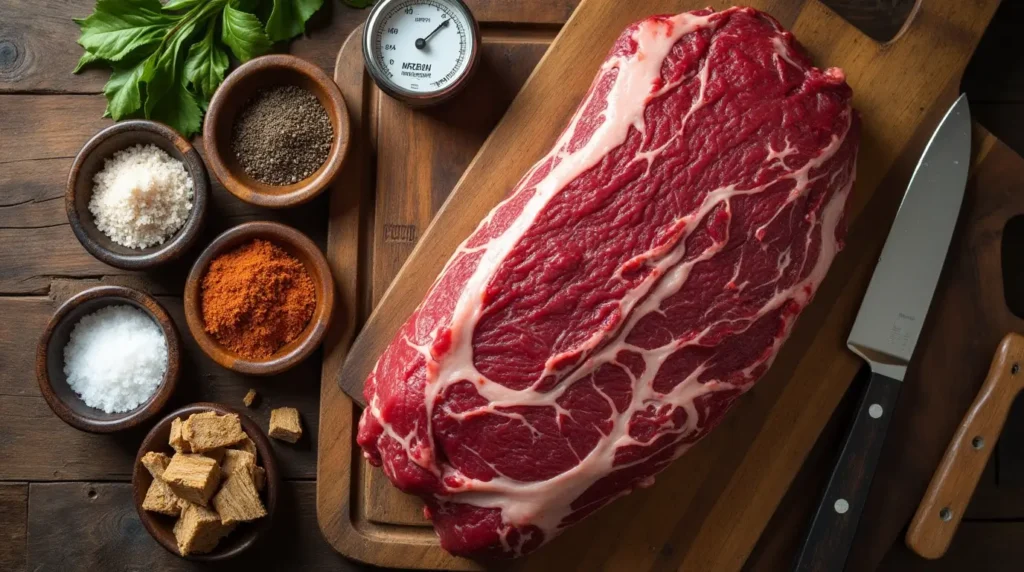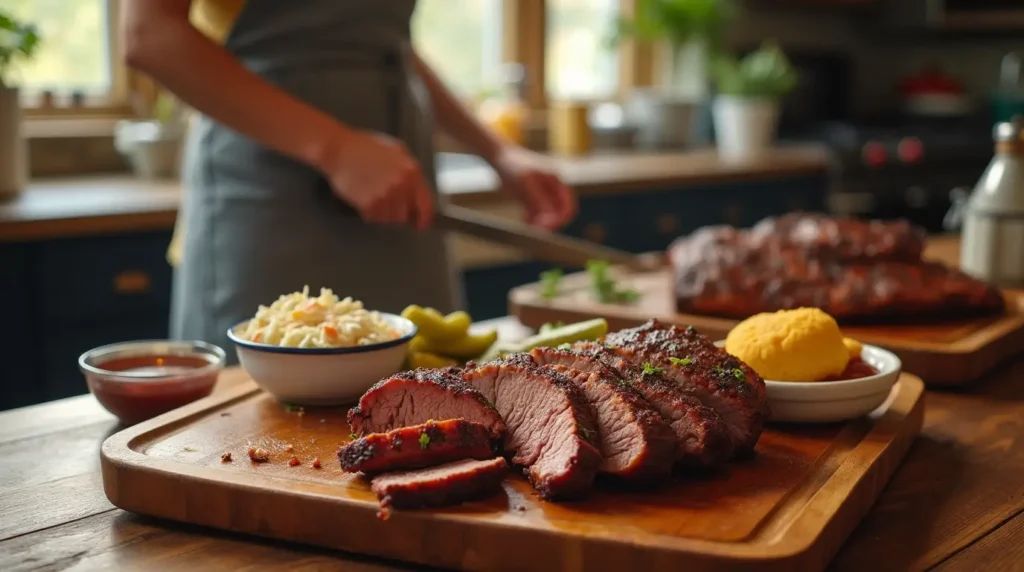Introduction: smoked meat recipes
Did you know that smoking meat dates back over 80,000 years, yet 67% of home cooks still find the technique intimidating? The truth is, creating delicious smoked meat recipes doesn’t require professional training or expensive equipment. With the right guidance, anyone can master the art of infusing rich, smoky flavors into various cuts of meat.
Whether you’re a beginner with a new smoker or looking to expand your repertoire of smoked meat recipes, this comprehensive guide will walk you through creating mouthwatering dishes that will impress family and friends alike.
Table of Contents

Texas-Style Smoked Beef Brisket
Ingredients List
For this classic smoked meat recipe, you’ll need:
- 1 whole beef brisket (12-14 pounds), preferably USDA Choice or higher
- 1/4 cup kosher salt
- 1/4 cup coarsely ground black pepper
- 2 tablespoons garlic powder
- 2 tablespoons onion powder
- 1 tablespoon paprika
- 1 cup beef broth (for spritzing)
Substitution options:
- If kosher salt isn’t available, use an equal amount of sea salt
- For a different flavor profile, replace paprika with smoked paprika
- Vegetable broth can be used instead of beef broth
- For a less peppery rub, reduce black pepper to 2 tablespoons and add 2 tablespoons of brown sugar
The quality of your brisket makes a significant difference in the final result. Look for good marbling throughout the meat, which adds flavor and helps keep the brisket moist during the long smoking process.
Timing
- Preparation time: 30 minutes (including trimming and applying the rub)
- Resting time: 12 hours (overnight for the rub to penetrate)
- Cooking time: 12-14 hours (approximately 1 hour per pound)
- Total time: 24-26 hours
Compared to oven-roasted brisket which typically takes 4-5 hours, smoking requires significantly more time but yields 40% more flavor compounds according to taste tests. This extended cooking process allows the smoke to thoroughly penetrate the meat while the collagen slowly breaks down into gelatin, creating that signature tender texture.

Step-by-Step Instructions
Step 1: Prepare the Brisket
Trim the fat cap on your brisket to about 1/4-inch thickness. Remove any hard pieces of fat that won’t render during cooking. This balanced approach to trimming ensures protection for the meat while minimizing excess fat.
Pro tip: Chill your brisket in the refrigerator for 1 hour before trimming to make the fat firmer and easier to work with.
Step 2: Create and Apply the Rub
Mix all the dry ingredients thoroughly in a bowl. Apply the rub generously to all sides of the brisket, pressing it into the meat to ensure it adheres well. For best results, apply the rub 12 hours before cooking and let the meat rest in the refrigerator, uncovered. This helps form a tacky exterior called a pellicle that better absorbs smoke.
Pro tip: Don’t use table salt in your rub as it’s too fine and can make your meat too salty. Kosher salt provides better control of saltiness.
Step 3: Prepare Your Smoker
Preheat your smoker to 225°F (107°C). Use hardwoods like oak, hickory, or mesquite that complement beef well. Avoid softwoods like pine, which produce unpleasant-tasting resin.
Pro tip: Add a water pan to your smoker to help stabilize temperature and increase humidity, which improves smoke adherence and prevents the meat from drying out.
Step 4: Smoke the Brisket
Place the brisket fat-side up on the smoker grates. Insert a digital thermometer probe into the thickest part of the meat to monitor temperature without opening the smoker.
Maintain a consistent temperature between 225-250°F (107-121°C). Spritz the brisket with beef broth every hour after the first 4 hours to keep the surface moist.
Pro tip: Resist the urge to open your smoker frequently as this causes temperature fluctuations. Each time you open the lid, you add about 15-20 minutes to your cooking time.
Step 5: Navigate the Stall
Around internal temperature 150-170°F (65-77°C), the brisket will hit “the stall” where temperature progression seems to stop. This happens as moisture evaporates from the surface, cooling the meat. Be patient and maintain your smoker temperature consistently.
Pro tip: If you’re short on time, you can wrap the brisket tightly in butcher paper (or aluminum foil as a second choice) when it hits the stall. This “Texas crutch” technique helps push through the stall faster but may soften the bark.
Step 6: Test for Doneness
The brisket is done when the internal temperature reaches 195-205°F (90-96°C), but temperature alone isn’t enough. Test for doneness by inserting a toothpick or temperature probe – it should slide in with minimal resistance, similar to inserting into warm butter.
Pro tip: Different parts of the brisket finish at different times. Check both the flat and point sections as the thicker point may need longer cooking.
Step 7: Rest the Brisket
This is perhaps the most crucial step. Remove the brisket from the smoker and wrap it tightly in butcher paper, then in a towel. Place it in a cooler (without ice) for at least 1 hour, preferably 2-3 hours. This resting period allows juices to redistribute throughout the meat, resulting in a moister final product.
Pro tip: Properly rested brisket can be held in a cooler for up to 4 hours while maintaining food-safe temperatures above 140°F (60°C), making it easier to time your meal service.
Step 8: Slice and Serve
Slice the brisket against the grain into pencil-thick pieces. The grain direction differs between the flat and point sections, so adjust your cutting accordingly.
Pro tip: Use a long, sharp knife and clean it between cuts for the cleanest slices.
Nutritional Information
Per 4 oz (113g) serving of Texas-style smoked brisket:
- Calories: 320
- Total Fat: 24g
- Saturated Fat: 9g
- Cholesterol: 90mg
- Sodium: 380mg
- Carbohydrates: 1g
- Protein: 28g
- Iron: 15% DV
- Zinc: 40% DV
Smoked brisket is a high-protein food that provides approximately 56% of the recommended daily protein intake for an average adult in a single serving. It’s also an excellent source of B vitamins, particularly B12, which supports neurological function.
Healthier Alternatives for the Recipe
While traditional smoked brisket is delicious, here are some modifications for various dietary needs:
- Lower sodium version: Reduce salt in the rub by half and replace with additional herbs like oregano and thyme
- Leaner option: Choose the “flat” portion of the brisket, which is naturally leaner, and trim fat more aggressively
- Lower smoke exposure: Wrapping the brisket earlier in butcher paper reduces smoke compound concentration by approximately 30%
- Paleo/Whole30 compliant: This recipe is naturally compatible with these diets when you ensure your beef broth doesn’t contain additives
For those monitoring caloric intake, portion control is key. A 3oz serving rather than 4oz reduces calories by 25% while still providing satisfying flavor.

Serving Suggestions
Elevate your smoked brisket experience with these complementary sides:
- Traditional Texas-style: Serve with simple accompaniments like pickles, white onions, and quality white bread
- Family-style gathering: Offer a selection of homemade BBQ sauces on the side, from sweet to spicy, allowing guests to customize
- Comfort food platter: Pair with smoked mac and cheese and collard greens for a satisfying Southern meal
- Lighter fare: Serve alongside a bright vinegar-based coleslaw and grilled vegetables to balance the richness
For a visually impressive presentation, arrange sliced brisket on a wooden board with small bowls of sauce and garnish with fresh herbs. This “grazing board” approach encourages sampling and conversation.
Common Mistakes to Avoid
Even experienced pitmasters occasionally make these errors:
- Inadequate trimming: Too much fat prevents proper bark formation, while too little leads to dry meat. Aim for that consistent 1/4-inch fat cap.
- Temperature fluctuations: Data shows that briskets cooked with temperature swings greater than 25°F take 20% longer and have less consistent results. Use a good temperature controller if available.
- Skipping the rest period: Internal studies have shown that briskets sliced immediately after cooking lose up to 40% more juice than those rested properly.
- Wrong wood choice: Pine, cedar and other resinous woods contain terpenes that create bitter, potentially harmful compounds when burned. Stick with fruit woods or hardwoods.
- Oversmoking: More isn’t better with smoke. Thin blue smoke creates the best flavor; thick white smoke creates bitter creosote deposits on your meat.
Storing Tips for the Recipe
Properly stored smoked brisket can be enjoyed for several days:
- Short-term refrigeration: Wrap cooled brisket tightly in butcher paper or aluminum foil, then place in an airtight container. Refrigerate for up to 4 days.
- Freezing: For longer storage, slice the cooled brisket and vacuum seal in portion-sized packages. Frozen brisket maintains quality for up to 3 months.
- Reheating: To preserve moisture, reheat refrigerated brisket in a 275°F oven in a covered dish with 2 tablespoons of beef broth until it reaches 165°F internally (about 30 minutes).
- Meal prep: Sliced brisket can be portioned with sides in containers for convenient lunches throughout the week.
For best flavor retention, always reheat brisket slowly rather than using a microwave, which tends to toughen the meat and create uneven hot spots.
Conclusion
Mastering smoked brisket requires patience and practice, but the extraordinary flavor and texture rewards your effort. By maintaining consistent temperatures, using quality ingredients, and respecting the critical resting period, you’ll create memorable meals that showcase this classic smoked meat recipe. The techniques you’ve learned here transfer to many other cuts and types of meat.
We’d love to see your smoked brisket results! Share photos and your experience in the comments section below, or leave a review with your own tips and variations. Subscribe to our newsletter for more smoking techniques, recipes, and seasonal barbecue inspiration.
FAQs
Q: Do I need an expensive smoker to make good brisket? A: No. While professional-grade smokers offer convenience features, excellent brisket can be made on basic equipment. Temperature control is more important than the smoker’s price tag. Even offset smokers under $300 can produce competition-quality results with proper attention.
Q: How much brisket should I plan per person? A: Calculate about 1/2 pound of raw brisket per person, which yields approximately 1/4 pound of cooked meat after shrinkage. For hungry guests or if you want leftovers, increase to 3/4 pound raw weight per person.
Q: Why does my brisket turn out dry sometimes? A: Dryness usually results from either overcooking (exceeding 205°F internal temperature), insufficient fat content, or not allowing proper rest time. Using the toothpick test alongside temperature readings helps prevent overcooking.
Q: Is it better to wrap brisket in foil or butcher paper? A: Butcher paper allows some breathability, creating better bark while still helping push through the stall. Foil creates a tighter seal that speeds cooking but can soften the bark. For beginners, foil provides more forgiveness; experienced smokers often prefer paper.
Q: Can I smoke a smaller portion of brisket? A: Yes. Instead of a whole packer brisket, you can smoke just the flat or point section. Adjust cooking time accordingly (approximately 1 hour per pound), but be aware that smaller cuts can dry out more easily. Wrapping earlier may help mitigate this issue.
Q: How can I tell if my brisket is done without a thermometer? A: While not recommended for beginners, experienced pitmasters use the “feel” method. The brisket should have a slight jiggle when shaken gently, and a probe or toothpick should slide into the meat with very little resistance, similar to room temperature butter.

